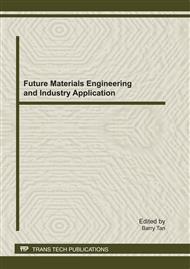[1]
Aitken, C.M., Jones, D.M., Larter, S.R. 2004. Anaerobic hydrocarbon biodegradation in deep subsurface oil reservoirs. Nature. 431: 291–294.
DOI: 10.1038/nature02922
Google Scholar
[2]
Aske, N., Kallevik, H., Sjöblom, J. 2001. Determination of saturate, aromatic, resin, and asphaltenic (SARA) components in crude oils by means of infrared and near-infrared spectroscopy. Energy Fuels. 15: 1304–1312.
DOI: 10.1021/ef010088h
Google Scholar
[3]
Banat, I.M. 1995. Biosurfactants production and possible uses in microbial enhanced oil recovery and oil pollution remediation–a review. Bioresour. Technol. 51: 1–12.
DOI: 10.1016/0960-8524(94)00101-6
Google Scholar
[4]
Bordoloi, N.K., Konwar, B.K. 2008. Microbial surfactant-enhanced mineral oil recovery under laboratory conditions. Colloids and Surfaces B: Biointerfaces. 63: 73-82.
DOI: 10.1016/j.colsurfb.2007.11.006
Google Scholar
[5]
Fan, T.G., Buckley, J.S. 2002. Rapid and accurate SARA analysis of medium gravity crude oils. Energy & Fuels. 16: 1571–1575.
DOI: 10.1021/ef0201228
Google Scholar
[6]
Fang, X.D., Wang, Q.H., Bai, B.J., Liu, X.C., Tang, Y.C., Shuler, P.J., Goddard, W.A. 2007. Engineering rhamnolipid biosurfactants as agents for microbial enhanced oil recovery. SPE106048. 2007 SPE international symposium on oilfield chemistry held in Houston, Texas, U.S.A., Feb. 28-March 2, (2007).
DOI: 10.2118/106048-ms
Google Scholar
[7]
Huang, X.F., Liu, J., Lu, L.J., Wen, Y., Xu, J.C., Yang, D.H., Zhou, Q. 2009. Evaluation of screening methods for demulsifying bacteria and characterization of lipopeptide bio-demulsifier produced by Alcaligenes sp. Bioresource Technology. 100: 1358–1365.
DOI: 10.1016/j.biortech.2008.08.004
Google Scholar
[8]
Nazina, T.N., Grigor'ian, A.A., Shestakova, N.M., Babich, T.L., Ivoĭlov, V.S., Feng, Q., Ni F., Wang, J., She, Y., Xiang, T., Luo, Z., Beliaev, S.S., Ivanov, M.V. 2007a. Microbiological investigations of high-temperature horizons of the Kongdian petroleum reservoir in connection with field trial of a biotechnology for enhancement of oil recovery. Mikrobiologiia. 76: 329-39 (in Russian).
DOI: 10.1134/s0026261707030058
Google Scholar
[9]
Nitu, S., Banwari, L. 2008. Isolation and characterization of a potential paraffin-wax degrading thermophilic bacterial strain Geobacillus kaustophilus TERI NSM for application in oil wells with paraffin deposition problems. Chemosphere. 70: 1445–1451.
DOI: 10.1016/j.chemosphere.2007.08.071
Google Scholar
[10]
Roling, W.F., Head, I.M., Larter, S.R. 2003. The microbiology of hydrocarbon degradation in subsurface petroleum reservoirs: perspectives and prospects. Res. Microbiol. 154: 321–328.
DOI: 10.1016/s0923-2508(03)00086-x
Google Scholar
[11]
Mulligan, C.N., Cooper, D.G., Neufeld, R.J. 1984. Selection of microbes producing biosurfactants in media without hydrocarbons. J. Ferment. Technnl. 62: 311–314.
Google Scholar
[12]
Tomotake, M., Tokuma, F., Masaaki, K., Tomohiro, I., Shuhei, Y., Masaru, K., Atsushi, S. 2009. Production of a novel glycolipid biosurfactant, mannosylmannitol lipid, by Pseudozyma parantarctica and its interfacial properties. Applied Microbiology & Biotechnology 83: 1017–1025.
DOI: 10.1007/s00253-009-1945-4
Google Scholar
[13]
Youssef, N., Elshahed, M.S., McInerney, M.J. 2007. Microbial processes in oil fields: culprits, problems, and opportunities. Adv. Appl. Microbiol. 66: 141–251. Review.
Google Scholar


